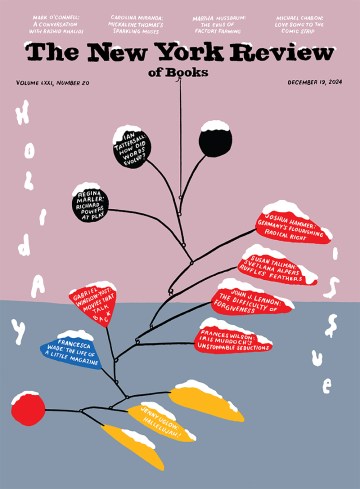A life in literary criticism: how Review writers read and responded to the novels of Toni Morrison (1931–2019).
Diane Johnson, “The Oppressor in the Next Room,” November 10, 1977 (Song of Solomon)
Morrison’s effect is that of a folktale in which conventional narrative qualities like unity and suspense are sacrificed to the cumulative effects of individual, highly romantic or mythic episodes, whose individual implausibility, by forcing the reader to abandon the criteria of plausibility, cease to matter. In this way, the writer can imply that hers are not descriptions of reality but only symbols of a psychological condition. Yet if her tales are merely symbolic, the reader can complain of their sensationalism. If they are true, her view of a culture in which its members, for whatever reasons, cannot depend for safety and solace on even the simplest form of social cooperation is almost too harrowing to imagine. »
Darryl Pinckney, “Every Which Way,” April 30, 1981 (Tar Baby)
The laboring poor of The Bluest Eye, the self-sufficient women and drifting men of Sula, the avaricious middle class and defiantly marginal citizens of Song of Solomon—they are gone, replaced, in Tar Baby, by the rich, their servants, their dependents, and the sans culottes who threaten their security. Though much is made of money, fashion, commodities as consciousness, and the experiences open to the privileged, the cultured, and those clever enough to hustle a piece of the action, the people living on Isle des Chevaliers, voluntary exiles all, seem to inhabit a world that is oppressively parochial and provincial…
Many of Morrison’s previous concerns are here—having to do with the inner life of black women and especially the offhand, domestic violence and conjugal brutality that burn out daily life. Much of the recent fiction by Afro-American women contains these themes. Their message is new and arresting, as if, in the past, the worries of the kitchen or the bedroom were not sufficiently large to encompass the intense lives of black people in a racist society. But Tar Baby’s sense of such experience is inchoate, muffled. »
Thomas Edwards, “Ghost Story,” November 5, 1987 (Beloved)
Stories are important—they are in fact all we have of the past—yet at the end the voice that tells Beloved’s story insists that hers is “not a story to pass on,” even though that voice has been passing it on for 275 pages. It should not be told, it will be told—the paradox is unresolvable. The memory—personal, political, poetical—of a social horror of such magnitude may distort or cancel living possibilities; but living possibilities, pursued without regard for such memories, are pretty sure to be trivial, empty possibilities in the end. »
Michael Wood, “Life Studies,” November 19, 1992 (Jazz and Playing in the Dark)
The simplest of public incidents, of the kind that make it into the newspapers, arise from complicated private stories, and such stories, connecting blunt or bitter fact with its riddling context or history, have always been Morrison’s business as a novelist. And not only as a novelist. In her introduction to an interesting volume of essays on the Anita Hill-Clarence Thomas affair, Morrison distinguishes between “what took place” and “what happened,” where the former is what can be briefly stated in a newspaper, say, and the latter is what we might, after patient thought and considerable investigation, actually understand. We live in a world of what the narrator of Jazz calls “a crooked kind of mourning,”—crooked as a path may be crooked, unavoidably indirect—and the phrase takes us a good way into Morrison’s moral landscape. »
Patricia Storace, “The Scripture of Utopia,” June 11, 1998 (Paradise)
Paradise pulls off a rare and stunning feat: it is a novel with a double life, a serious work of fiction which also functions as a parable, a novel that is, effectively and ironically, also a work of literary criticism. Paradise, perhaps more directly than any of Toni Morrison’s other novels, draws that black presence forward from the margins of imagination to the center of American literature and history. With the ambiguity of illusion that Magritte used in his painting The Human Condition, in which the image of the sky on an easel may be a painting or the world outside the room, Morrison tells a story of an African-American community in the Vietnam era which is also a story about colonial America. »
Darryl Pinckney, “Hate,” December 4, 2003 (Love)
Although Morrison has also been known as the publisher of black women writers such as Gayl Jones and Toni Cade Bambara, she wasn’t writing the kind of thing the period is remembered for: the feminist critique of black men. Its absence in her own work has always set her apart from other black women writers who emerged on the scene around the same time she did. The women’s movement was entering another popular phase in the 1970s, but Morrison, in looking back, said she couldn’t understand why white women were talking about loving one another, because to her way of thinking black women had always understood the importance of friendships among women…
Advertisement
More than any other black writer in contemporary African-American literature, and without its being her primary intention, Morrison captures the battles of class and the struggles to define status that are part of the history of the places where black people were allowed or where they turned up, whether in the stuffy midwestern pocket of Song of Solomon or the dry all-black Oklahoma town of Paradise. Then, too, Morrison respects the entrepreneurial pride some black people had in spite of segregation—making a way out of no way, as the saying went. As a single parent, a working mother, Morrison, the Nobel Laureate, spent two decades in an office and before that was a college instructor. “You can’t idealize hard work,” she said, before adding that the great home of the soul is the open road. »
Wyatt Mason, “The Color Money,” March 12 2009 (A Mercy)
Naturally, the story of a country has many more meanings than a fable can reasonably contain. Morrison’s A Mercy seeks that vaster quarry. Like Faulkner in As I Lay Dying, Morrison employs a range of reporters to cover a focal event from multiple viewpoints. Any one of these reports tells much of the story, but only in concert is a full understanding of events and implications attained. As in Faulkner, the event is a journey, but where his delivers a dying woman to her grave, Morrison’s would keep a dying woman from reaching hers. »
Christopher Benfey, “Ghosts in the Twilight” July 12, 2012 (Home)
Home has a sparer, faster pace than earlier Morrison novels like Beloved or Jazz, as though a drumbeat is steadily intensifying in the background and the storyteller has to keep up. Morrison signals this percussive narrative drive when, during his journey south, Frank listens to a jazz trio in a local dive: “After long minutes, the pianist stood and the trumpet player put down his horn. Both lifted the drummer from his seat and took him away, his sticks moving to a beat both intricate and silent.” As Frank concludes, “The rhythm was in charge.”…
Home…places two familiar stories, like jazz standards, in unlikely counterpoint. One is the coming-home narrative, as old as Homer, with a soldier bearing battle scars returning to a changed domestic scene. The other is the Grimms’ folktale “Hansel and Gretel,” that disturbing story of children repeatedly ejected from their unhomelike home, who stumble across a counterfeit home of gingerbread and sugar candy. The story has evidently held a particular urgency for Morrison since childhood. »
Francine Prose, “Growing Up Too Black,” May 7, 2015 (God Help the Child)
At various points the novel shifts from the familiar and the real to the allegorical and the mythic, and then shifts back again. The challenge that Morrison has set for herself is to have it both ways, more or less at once: to populate a fairy tale with credible human beings and to set it in a world in which the paranormal coexists with the same electronic gadgets and brand names we recognize from our own. »
Toni Morrison, introduction to On the Radiance of the King by Camara Laye, August 9, 2001
If one is writing within and about an already “raced” milieu, advocacy and argument are irresistible. Rage against the soul murder embedded in the subject matter runs the risk of forcing the “raced” writer to choose among a limited array of strategies: documenting their seething; conscientiously, studiously avoiding it; struggling to control it; or, as in this instance, manipulating its heat. Animating its dross into a fine art of subversive potency. Like a blacksmith transforming a red-hot lump of iron into a worthy blade, Camara Laye exchanged African “enigma” and darkness for subtlety, for literary ambiguity. Eschewing argument by assertion, he claimed the right to intricacy, to nuance, to insinuation—claims which may have contributed to a persistent interpretation of the novel either as a simple race-inflected allegory or as dream-besotted mysticism. »



